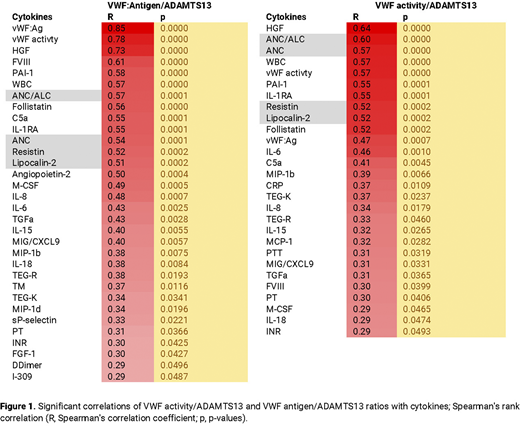BACKGROUND. COVID-19 is a prothrombotic disease, characterized by both arterial and venous thrombosis. The pathogenesis of coagulopathy in COVID-19 is multifactorial, with activation of endothelial cells, platelets, neutrophils, and other immune system effectors playing crucial roles. High levels of von Willebrand factor (VWF) and reduced levels of ADAMTS13 have been observed in COVID-19, sepsis, and immunothrombotic states, and an elevated VWF/ADAMTS13 ratio has been previously described in ischemic stroke1. In this study, we sought to evaluate potential associations of VWF activity and antigen ratios to ADAMTS13 with clinical outcomes in hospitalized patients with COVID-19 and to compare these ratios with other cytokines and markers of inflammation in critical illness.
METHODS. Institutional Review Board approval was obtained for this study. Blood was collected from 49 hospitalized patients with a confirmed diagnosis of COVID-19 between April 13 and April 24, 2020, which included 40 patients in an intensive care unit and 9 on a non-ICU unit. Medical records were reviewed, and patient characteristics including age, sex, comorbidities, pertinent medications, imaging studies, history of arterial or venous thrombosis, and other pertinent patient information were compiled. Blood was collected in sodium citrate tubes and centrifuged at 4000 rpm for 20 minutes, with the resulting plasma supernatant used for further testing. Measurements of VWF antigen and VWF activity were performed on an ACL TOP machine using our institution's standard clinical laboratory protocol. Biomarker profiling analyses were performed at Eve Technologies (Calgary, Alberta, Canada). Statistical analysis was performed using GraphPad Prism (v8.4.3, GraphPad Software, San Diego, CA) and R (v4, R Core Team, 2020). P values <0.05 were considered statistically significant.
RESULTS. The median age was 64 years; 36 (73%) were male, 11 (22.4%), 29 (59.2%), and 9 (18.4%) had BMI<25, between 25 and 40, and >40 kg/m2, respectively. The ratio of VWF activity/ADAMTS13 was significantly higher in patients with higher BMI (median [interquartile range, IQR] VWF activity/ADAMTS13 ratios: 0.66 [0.39-0.88] for BMI<25 kg/m2, 0.865 [0.769-1.102] for BMI 25-40 kg/m2, and 1.041 [0.747-2.032] for BMI>40 kg/m2; p = 0.0408, Kruskal-Wallis test). In patients who required mechanical ventilation, median [IQR] VWF activity/ADAMTS13 was 0.876 [0.75-1.769] vs 0.792 [0.566-0.932] for those who did not (p = 0.0497, Mann-Whitney U-test). The difference for the VWF antigen/ADAMTS13 ratio was more pronounced, 1.32 [0.991-2.456] vs 0.981 [0.628-1.162] (p = 0.0045, Mann-Whitney U-test). There was also a significant correlation between both VWF activity/ADAMTS13 and VWF antigen/ADAMTS13 ratios and neutrophil indices such as absolute neutrophil count (R = 0.57, p <0.0001 and R = 0.54, p = 0.0001, respectively) and neutrophil to lymphocyte count (R = 0.6, p <0.0001 and R = 0.57, p <0.0001, respectively). We also found significant correlations of these ratios with markers of neutrophils activation (HGF, resistin, and lipocalin-2; Figure 1).
CONCLUSIONS. Ratios VWF activity/ADAMTS13 and VWF antigen/ADAMTS13 are elevated in patients with more severe COVID-19 disease and correlate with markers of neutrophils activation. These findings and that azurophillic granules in neutrophils contain α-defensins implicated in thrombosis2 suggest possible mechanistic links among VWF, ADAMTS13, contact pathway, and neutrophil function in mediating immunothrombotic complications in COVID-19, which might highlight potential therapeutic targets to attenuate the severity of coagulopathy and merit further investigation with a larger cohort of patients.
REFERENCES
1. Taylor A, et al. Blood Adv. 2020;4(2):398-407
2. Abu-Fanne R, et al. Blood. 2019;133(5):481-493
No relevant conflicts of interest to declare.
Author notes
Asterisk with author names denotes non-ASH members.


This feature is available to Subscribers Only
Sign In or Create an Account Close Modal